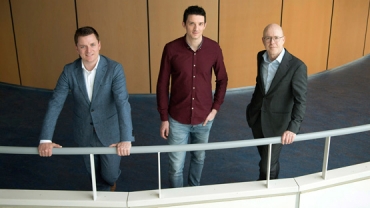
From product- to customer-focussed
Let’s say you have a complex and expanding portfolio comprising thousands of products and articles. Your sales teams work year-in, year-out to perfect their knowledge and to master the product roadmap, while your product and research teams are devoted to their creations and continue to work separately on stand-alone solutions. But are those solutions still relevant for your customers? That’s precisely the question that Unit4’s domestic division in the Benelux dared to ask openly two years ago, after which the company explored how its product portfolio had developed within the market over the years.
According to Victor ter Beke, Unit4’s Head of Commercial Operations Domestic Businesses, the figures made things perfectly clear. “Over the past twenty years, Unit4 has developed thousands of products, modules and articles,” he says. ”After our analysis, it became clear that most of our turnover was generated by only a small portion of our portfolio. More than half our products hadn’t even been sold in the previous two years. Our focus was too much on the products. But our customers don’t want products. They have an issue and they’re feeling pain. We need to understand that pain, take action based on that understanding, and resolve the issue for the customer concerned. How do we do that? We do it by understanding our customers even better, by understanding their needs even more. We’ve redesigned each business line on a four-step basis. This customer-focused commercial restructuring has led to us now working in a truly different, more efficient, and more impactful way by putting time and money into understanding our customers and building solutions that fit their processes and help solve their problems.”

"More than half our products hadn’t even been sold in the previous two years. Our focus was too much on the products. But our customers don’t want products. They have an issue and they’re feeling pain. We need to understand that pain, take action based on that understanding, and resolve the issue for the customer concerned."

"Value drivers that customers consider very important but that perform poorly need to be improved."
Step 1: customer archetypes and their needs
“Our first step toward becoming truly customer-focussed,” says Mr Ter Beke, “was to identify customer archetypes and their needs. We formed a cross-functional team that worked closely with customers and collected data over the course of a year so as to understand their needs better. Based on that data, we identified the potential values on which customers base their purchasing decisions. We then checked them according to the yardstick of relative importance and relative performance. That created four quadrants: value drivers that customers consider very important but that perform poorly need to be improved. Drivers that are of major importance and also high performance must be communicated. Factors that perhaps perform well but that are of little importance to the customer provide opportunities for cutting costs. And if drivers are of low importance and also low performance, you need to be aware of them but you don’t have to spend any more money on them. We then defined our product bundles on the basis of the values that are really important to our customers.”
Step 2: intelligent productbundling
When putting together the bundles, Unit4 structured its products in such a way that they form attractive combinations for each specific customer segment. “You can compare it to eating at McDonalds,” says Ter Beke. “You go to McDonalds for a Big Mac and order a menu based on it. McDonalds has segmented its customers extremely carefully and it knows exactly what the needs of those segments are. The various different menus have been put together based on those needs. The company responds cleverly to those needs with a sophisticated customer journey and a clever menu, ranging from Happy Meals for children to a salad menu for customers with a more 'health-conscious' appetite."


Step 3: lead products en add-ons
“When working out the bundles, it’s important to understand your customers and their needs,” says Ter Beke. “You cluster together customers with uniform needs or pains into ‘customer archetypes’. You then translate the functions and features of the product into benefits for those customers. After that you place those customer benefits on top of the needs. Based on these insights you then assemble the bundles. We’ve determined the most important products for each customer type – the lead products – and determined which benefits add value. Finally, we’ve determined what the add-ons are, in other words the modules that don’t create value for everybody. It’s important to understand them and not make them part of your bundle. McDonalds has also learned that if you include coffee and ice cream as standard components of your menu, a lot of people will just choose a burger. They don’t want to pay for something they won’t consume or don’t actually like."
Step 4: a logical pricing model for each bundle
"After identifying customer archetypes and their needs, compiling the bundles, and determining our lead products and add-ons, the fourth step was to set up a logical pricing model for each bundle", says Victor Ter Beke. "After seven months, we’d reduced several thousand individual articles to ten transparent bundles that are in line with the needs of our defined customer archetypes. The next practical challenge was to replace the thousands of separate items with the new product bundles in Salesforce CPQ Cloud, the only quotation tool that Unit4 uses. It was important for the bundles to be uploaded to CPQ correctly because as long as they weren’t listed in it, they couldn’t be sold. PwC helped us to upload the right bundles into CPQ in the correct manner.”


"Implementing Salesforce CPQ Cloud was actually only the means for carrying out the change. The key to success was getting all those involved into line so as to achieve joint decision-making."
Implementation Salesforce CPQ and PwC
PwC played a number of different roles in implementing the value creation programme at Unit4 in the Netherlands. Jasper Kakes, senior manager and engagement leader Salesforce at PwC, explains: “We launched and coordinated various different bundles in nine product areas for nine customer archetypes. We formed teams made up of people from the sales, marketing, and product management departments and made sure that they were all singing from the same song sheet. That was necessary because the three departments all had very different views regarding the product portfolio. We made them aware of how they could use their strengths to create the best possible portfolio for Unit4. Implementing Salesforce CPQ Cloud was actually only the means for carrying out the change. The key to success was getting all those involved into line so as to achieve joint decision-making.”
Victor ter Beke agrees: “PwC didn’t only implement the solution but acted as a real partner for us in this successful transformation, actively challenging about our thinking and the steps to be taken. The message right at the start was ‘If you choose us, you aren’t choosing a company that merely implements stuff’. And PwC stayed on-message: during our collaboration, they kept raising questions about the process and the items we wanted to input into the system. The discussions we had about that only served to strengthen our final value proposition.”
Staying customer-focussed through cooperation
Becoming customer-focused is one thing, but staying customer-focused is now the next challenge. The new culture will be sustained by means of a collaborative governance model that brings together sales, product, and marketing professionals. According to Mr Ter Beke, continuous pooling of knowledge between these parties leads to truly amazing results: ”Combining the departments into a single management model, combined with effective cooperation between product managers, sales managers, and marketing managers really is the key to success for every product company in today’s market. It’s not the product, the technology, or a specific customer deal that you need to focus on but the customer and what the customer needs. That way, the sales department can talk to the customer about the issues and needs per customer archetype, based on its specific business process and objectives. That approach will allow the department to come up with targeted solutions. The best salesman is no longer the one who knows all the products but the one who understands the customer best. In addition, it is easy to ‘upsell’ existing customers by using the bundles. The marketing department can arrange campaigns for each archetype in a language, in a medium, and with visuals that will appeal to the target group. We no longer communicate about functions and features but based on relevant issues, and that has had a direct impact on the number of website visitors and conversions. Together with their teams and their customers, our product managers can improve business in accordance with the characteristics from the high-importance and low-performance ‘value grid’. Focusing on the customer’s needs has ensured that the departments also work together even more effectively and efficiently. By teaming up and continuously validating and adapting product bundles to changing customer needs in a quick and satisfactory manner, we can really deliver what the customer needs.”

"Focusing on the customer’s needs has ensured that the departments also work together even more effectively and efficiently. By teaming up and continuously validating and adapting product bundles to changing customer needs in a quick and satisfactory manner, we can really deliver what the customer needs.”
Contact us



















